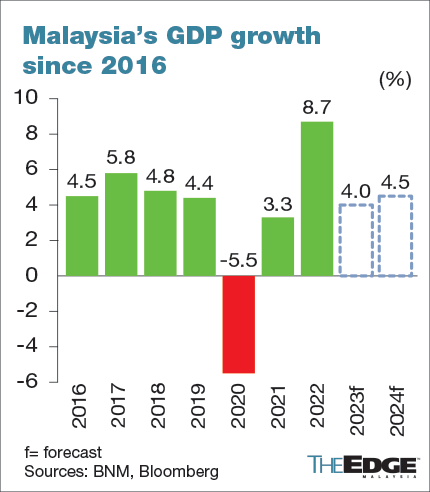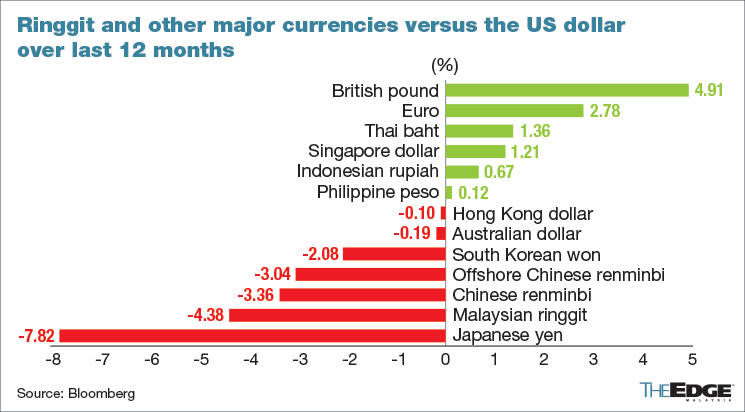
The country is widely expected to chart a stronger economic growth of 4-5% in 2024, but some headwinds may blow it off course. Here's a look at the top risks.
KUALA LUMPUR (Jan 3): Malaysia is widely expected to achieve the official forecast of 4-5% gross domestic product (GDP) growth this year, driven by the continued expansion of its domestic consumption that is underpinned by a resilient labour market, and potential recovery in global trades amid higher expectation that the US would avoid a recession.
But economists have also highlighted five top downside risks that may derail the country's anticipated GDP growth. Of them, four are external risks.
Geopolitical risks
Socio-Economic Research Centre (SERC) executive director Lee Heng Guie, who expects Malaysia GDP to grow by 4.5% in 2024, with the global economy forecasted to muddle through to a “soft landing” in 2024, said geopolitical tensions present macro risks to the country's growth.
“These include elevated trade tensions between the US and China, the ongoing conflict in Ukraine and the recent outbreak of war between Israel and Hamas in the Middle East,” he told The Edge.
Maybank Investment Bank — which expects a 4.4% GDP growth for Malaysia this year — pointed out that while US-China tensions seem to have eased somewhat after leaders of both countries met during the Apec Summit in San Francisco last November, core economic issues between the two largest economies remain, namely trade tariffs and restrictions in trade and investments in advanced technology.
“Currently, the market appears to be pricing in the scenarios of prolonged stalemate in Russia-Ukraine war, and no-or-low risk of Israel-Palestine conflict broadening into another episode of Middle East tension,” it said in a note last month.
UOB Malaysia's senior economist Julia Goh believes that geopolitical and macro risks will "continue to keep investors on edge in the near term.
“This could lead to a prolonged bottoming process for Asia currencies (including the ringgit) alongside the renminbi,” she told The Edge, forecasting a firmer Malaysia GDP growth of 4.6% in 2024.
“Ringgit has a high correlation to the renminbi, more so than other regional peers and Malaysia encounters a larger negative interest rate differential with the US rate than most countries [among regional peers].
“Hence, subsequent recovery in renminbi and a peak in the US Fed rates followed by expected Fed rate cuts would be key determinants to the ringgit performance in 2024,” she said, adding the local note's performance this year will continue to be driven by external factors.
China’s worrying growth prospects
Being the largest economy in Asia, China’s “underwhelming” post-pandemic growth is seen as a key downside risk to global and Asean economic outlook, according to Maybank IB.
In a note to clients on Tuesday, SPI Asset Management managing partner Stephen Innes noted that China’s factory activity and non-manufacturing PMI in December indicate a slowdown in recovery in the world's second largest economy.
“This development is expected to pressure fiscal and monetary policymakers to take urgent action, especially after leaders committed to maintaining a pro-growth stance in 2024.
"China requires more than just stimulating economic activity — it necessitates fundamental reform of the underlying growth engine,” he said.
China’s factory activity contracted for a third consecutive month in December, with manufacturing PMI dropping to 49.0 from 49.4 in November, while the service sector PMI sub-index in December remained in contraction at 49.3, same as November.
CGS-CIMB Securities head of economics Nazmi Idrus said among the reasons for the ringgit's weakness is China being its major trade partner, as the local currency has some affinity with the renminbi's movements.
“Even though the Fed (US Federal Reserve) is expected to cut [the benchmark rate in 2024], the rate reduction is only partial; it has raised rates by over 500 basis points (bps) so far but is expected to cut only by 100bps,” said Nazmi, who is forecasting a 4.6% GDP growth for Malaysia in 2024.
“The timing [of the cut] varies across analysts so that will determine the strength and timing of ringgit's appreciation. Regardless, a stronger ringgit will ease some of the imported inflation and perhaps improve the purchasing power,” he added.
Slower US growth, if not a full-blown recession
While the anticipation of a full-blown US recession has eased amid expectations that the Fed would be able to pull off a "soft-landing" this year, there are concerns of slowing growth in the world's largest economy, while worries of a downright recession still linger.
MIDF Research, while sanguine on Malaysia's growth in 2024 with an anticipated 4.7% GDP increase, still highlighted in a note on Tuesday that the risk of a US recession, alongside the escalation of geopolitical tensions that could bring another round of supply disruptions and fluctuations in the commodity and financial markets, would hurt Malaysia's growth outlook.
Maybank IB is expecting slower growth in the US. “The prospect of US growth “soft-landing” is enhanced by the falling risk of 2024 recession as the US yield curve is ‘flattening’ after the earlier ‘inversion’,” said the investment bank.
Key elections to watch
Maybank IB also highlighted several elections taking place in 2024 that may shape international relations and impact global growth.
“There are also several key elections taking place in 2024 that we need to keep an eye on — the presidential elections in US and Indonesia, as well as the Taiwan election,” said the investment bank in a note last month.
“The big one is [the] US Presidential election on Nov 5, 2024, considering that there is the possibility of a Trump comeback as opinion polls point to Trump leading President Biden by wide margins,” it noted.
Taiwan’s election is scheduled to be held this month, followed by Indonesia in February, India between April and May, and the European Parliament in June, before the November US presidential election.
Maybank IB said a comeback of former US president Donald Trump could potentially have wide-ranging policy impact in the US-China trade tariff and technology wars, which could lead to deteriorating bilateral relations.
“Indonesia will go into election on Feb 14, 2024 to pick President Jokowi’s successor, and thus [we] will see whether there will be policy continuity or change. Another key political event to watch is the Taiwan election on Jan 13, 2024, the outcome of which has bearings on US-China relations,” it added.
Domestic vulnerabilities
While Malaysia has a relatively stable political scene now compared with last year, there are vulnerabilities in the domestic economy that may weaken the country’s ability in weathering global uncertainties, economists noted.
Capital Economics' emerging Asia economist Shivaan Tandon, who is forecasting a 5% growth for Malaysia's GDP this year, cautioned that the country may struggle to record economic growth over the next few quarters, with inflation set to rise in 2024, and little room for the central bank to manoeuvre.
“Despite the rebound in GDP growth last quarter (to 3.3% in the third quarter of 2023 from 2.9% in 2Q), the near-term outlook for the economy is poor,” he told The Edge in an email reply.
“Meanwhile, weak global demand will drag on its exports of goods. Domestic demand is also likely to weaken. Fiscal policy is set to be tightened further in 2024 as the government tries to put the fiscal position on a more stable footing. The country’s debt-to-GDP ratio is among the highest in the region,” he said.
“Tight monetary policy will also drag on investment and consumption. While the scale of monetary tightening in Malaysia has been modest relative to elsewhere in Asia, high levels of household and corporate debt make the country especially vulnerable to higher borrowing costs.
While he noted that price pressures have eased sharply over the past year and weaker demand-side pressures will lead to further falls in core inflation, the headline rate is set to rise in the coming months after the government announced it would be cutting fuel and food subsidies next year.
Nevertheless, Shivaan said "the central bank will wait to assess the impact of the subsidy cuts rather than acting pre-emptively". His forecast is that interest rates will remain on hold throughout next year.
SERC’s Lee is expecting private consumption growth to normalise to 5.3% in 2023 and to slow to 4.6% in 2024, as households and consumers turn cautious in their discretionary spending.
“There are numerous reasons to expect consumer spending growth to slow in 2024: targeted subsidy rationalisation, high cost of living and inflation risk as well as higher service tax rate for some services,” he said.
As Malaysia looks ahead to 2024, the potential hurdles that lie in the path of its economic growth targets and the nation's ability to navigate around these uncertainties with limited fiscal room will be closely watched.
- Appellate court directs full trial for 10 purchasers of SkyPark @ Cyberjaya over partial CCC
- Former Petronas manager charged with disclosure of confidential information
- EcoWorld, SD Guthrie, NS Corp ink deal for joint venture to advance N Sembilan’s RM2.95b industrial park
- YTL Power unit wins bid to develop fibre optic along rail lines as RAC breaks industry monopoly
- Malaysia ready to develop Pan-Asian Railway Network — Loke
- Trump studying whether to fire Fed chair Powell, adviser says
- White House seeks to bring financial regulators under its sway
- Capital One deal for Discover wins approval from US regulators
- Trump releases files on 1968 assassination of Robert F Kennedy
- China speeds up budget spending to counter tariff woes


